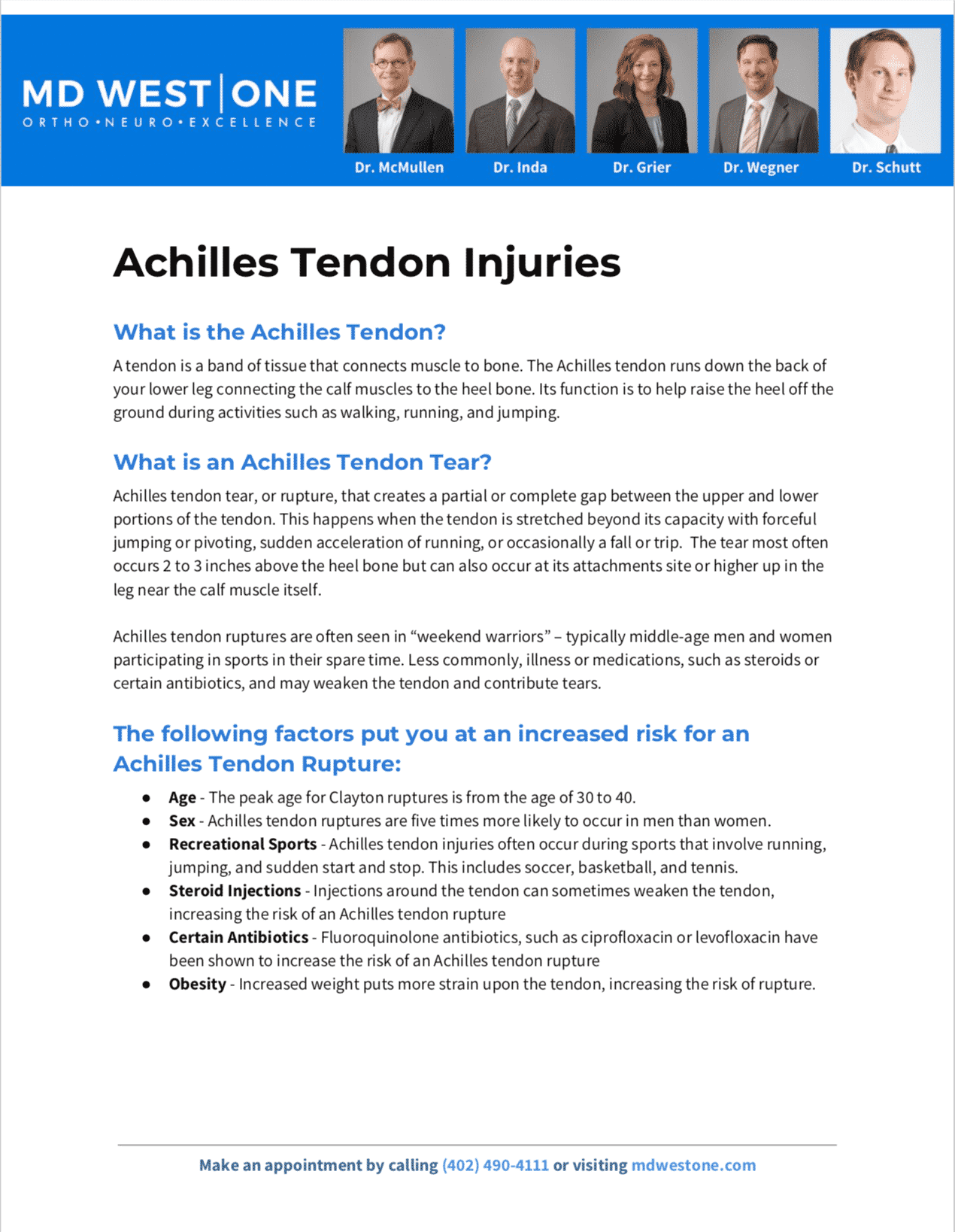Are you suffering from potential Jones Fracture?
The Omaha Foot & Ankle Specialists at MD West ONE are able to properly diagnose and treat Jones Fracture through both surgical and non-surgical treatments. If you have the following symptoms, you may want to make an appointment with one of our Board Certified Specialists.
- Pain
- Swelling
- Tenderness
- Difficulty walking like you usually can
- Bruising or discoloration
- A deformity or bump that is not usually on your foot
Meet MD West ONE's foot and ankle specialists and learn more about how they treat Jones Fracture.
Jones Fracture Causes, Treatments & Surgery
What is Jones Fracture?
Jones fracture are caused when you put sudden force on the outside of your foot with your foot twisted away from your body. Repeated overuse, sports injuries and falls are the most common causes of Jones fractures. You might need surgery to repair your bone. Most people need a few months to recover from a Jones fracture.
The following factors put you at an increased risk for Jones Fracture:
Jones fracture — like all bone fractures — can affect anyone. You are more at risk for a Jones fracture if you regularly put a lot of stress on your feet in ways most people do not. Some examples of this include:
-
Athletes
-
Dancers
-
Workers who walk or stand most of the time
Men around 30 and women over 70 are also more likely to experience Jones fracture than other age groups.
People with osteoporosis have an increased risk for all types of broken bone, including Jones fracture.
Ways to Decrease Your Risk of Developing Jones Fractures:
- Wear the right protective equipment for all activities and sports.
- Make sure your home and workspace are free from clutter that could trip you or others.
- Always use the proper tools or equipment at home to reach things. Never stand on chairs, tables or countertops.
- Follow a diet and exercise plan that will help you maintain good bone health.
- Talk to your provider about a bone density test if you’re older than 50 or if you have a family history of osteoporosis.
DIAGNOSIS
Your healthcare provider will diagnose a Jones fracture with a physical exam and imaging tests.
What tests are done to diagnose a Jones fracture?
After a physical exam, you will likely need at least one of a few imaging tests:
- X-rays: An X-ray will confirm any Jones or other fractures and show how damaged your bones are.
- Magnetic Resonance Imaging (MRI): Your provider might use an MRI to get a complete picture of the damage to your bones and the area around them. This will show them tissue around your bones too. This is especially important to determine if your muscles or connective tissue were injured.
- CT scan: If you need surgery, your provider or surgeon needs to know exactly how damaged your bones are. A CT scan will give them a more detailed picture of your bones and the surrounding tissue than an X-ray.
NON-SURGICAL TREATMENT OPTIONS
How your Jones fracture is treated depends on the severity of the original break. Your broken bones need to heal back together. Depending on how damaged they are and what caused them to break, there are a few treatments your provider might use.
Immobilization
If your break is mild and the bones did not move far out of place (if it is non-displaced), you might only need a cast or boot. You will typically wear them for six to eight weeks. In both cases you will likely need to follow up X-rays to make sure your bones are healing correctly.
Closed reduction
More severe breaks require a closed reduction to set (realign) your bones. During this non-surgical procedure, your provider will physically push and pull your body on the outside to line up your broken bones on the inside. To prevent you from feeling pain during the procedure you will receive one of the following:
- Local anesthetic to numb the area around your fracture.
- Sedatives to relax your whole body.
- General anesthesia to make you sleep through the procedure.
After the closed reduction, your provider will put you in a cast or boot.
SURGICAL TREATMENT OPTIONS
Internal fixation
The most intense fractures require surgery. Your surgeon will realign (set) your bones to their correct position and then secure them in place so they can heal and grow back together. They usually perform what’s called an internal fixation, which means your surgeon inserts pieces of metal into your bone to hold it in place while it heals. Internal fixation techniques include:
- Rods: A rod inserted through the center of your bone that runs from top-to-bottom.
- Plates and/or screws: Metal plates screwed into your bone to hold the pieces together in place.
- Pins and wires: Pins and wires hold pieces of bone in place that are too small for other fasteners. They will typically be used at the same time as either rods or plates.
Some people live with these pieces inserted in them forever. You might need follow-up surgeries to remove them.
Bone grafting
You might need bone grafting if your Jones fracture is severely displaced or if your bone is not healing back together as well as it should. Your surgeon will insert additional bone tissue to rejoin your fractured bone. After that, they will usually perform an internal fixation to hold the pieces together while your bone regrows. Bone grafts can come from a few sources:
- Internally from somewhere else in your body — usually the top of your hip bone.
- An external donor.
- An artificial replacement piece.
Jones fracture surgeries are usually outpatient procedures, and you should be able to go home the same day.
After your surgery, your foot will be immobilized. You will need to wear a boot or cast before you can start putting any weight on it again or using it like you did before your fracture.
It could take a few weeks for your symptoms to improve before you can begin walking again. Depending on which type of surgery you have, you might not be able to put weight on your foot for up to eight weeks. Gradually, you will be able to add in more activity. You should be able to resume all your normal activities — including playing sports — in 3 to 4 months.
If you experience intense pain that does not get better contact your healthcare provider right away.
Frequently Asked Questions?
How common are Jones fractures?
Jones fractures are one of the most common foot fractures. They are especially common in athletes, dancers, and people with jobs that require them to be on their feet constantly.
Jones fractures are caused by a sudden impact to your foot while it is twisted, usually with your heel lifted. Some of the most common causes include:
- Repeated overuse: Walking, running, or standing on hard surfaces for too long.
- Sports injuries: Jumping like in basketball or dancing, or twisting quickly like in soccer or football.
- Falls and slips: Tripping on the stairs, or catching yourself suddenly after slipping on a wet floor, for example.
How can I prevent a Jones fracture?
Avoid overusing your feet if possible. Give your body time to rest and recover after intense physical activity. If you use a walker or cane to help walk, never try walking without it. Be sure to be careful while walking on uneven surfaces.
AMERICAN ORTHOPAEDIC FOOT & ANKLE SOCIETY
All of the foot and ankle surgeons in the practice are recognized members of the American Orthopaedic Foot & Ankle Society. It is the oldest and most prestigious medical society dedicated to the foot and ankle. The mission of the society is to advance science and practice of foot and ankle surgery through education, research, and advocacy on behalf of patients and practitioners. These physicians dedicate their time and energy to improving the patient experience and their knowledge in their field. For more information visit http://www.aofas.org.
MD West ONE Foot & Ankle Specialists:
The Foot & Ankle Specialists are all Board Certified and Fellowship-Trained, meaning they’ve focused their education, training and research on orthopaedic surgery of the foot and ankle.






